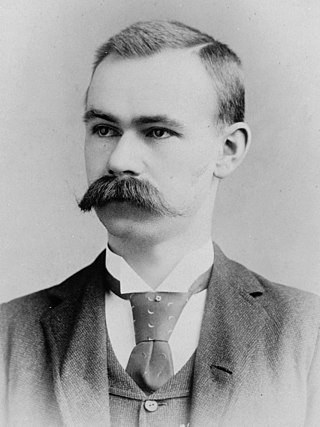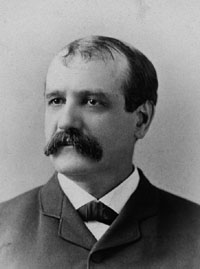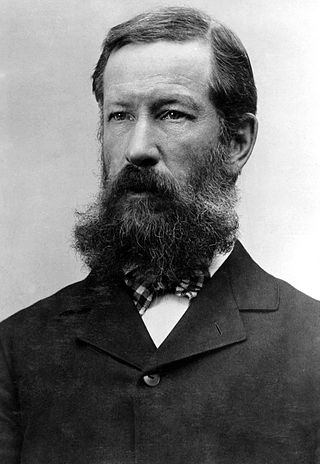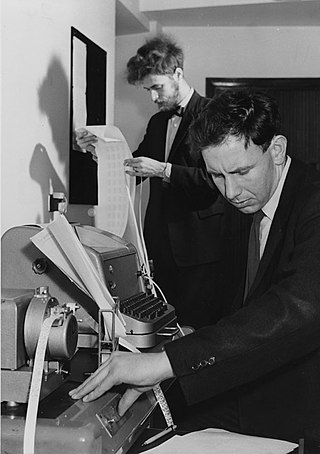
Herman Hollerith was a German-American statistician, inventor, and businessman who developed an electromechanical tabulating machine for punched cards to assist in summarizing information and, later, in accounting. His invention of the punched card tabulating machine, patented in 1884, marks the beginning of the era of mechanized binary code and semiautomatic data processing systems, and his concept dominated that landscape for nearly a century.

A punched card is a piece of card stock that stores digital data using punched holes. Punched cards were once common in data processing and the control of automated machines.
Data processing is the collection and manipulation of digital data to produce meaningful information. Data processing is a form of information processing, which is the modification (processing) of information in any manner detectable by an observer.

The United States Census Bureau (USCB), officially the Bureau of the Census, is a principal agency of the U.S. Federal Statistical System, responsible for producing data about the American people and economy. The Census Bureau is part of the U.S. Department of Commerce and its director is appointed by the President of the United States.

The Powers Accounting Machine was an information processing device developed in the early 20th century for the U.S. Census Bureau. It was then produced and marketed by the Powers Accounting Machine Company, an information technology company founded by the machine's developer. The company thrived in the early 20th century as a producer of tabulating machines. It was a predecessor to the Unisys corporation.

Starting at the end of the nineteenth century, well before the advent of electronic computers, data processing was performed using electromechanical machines collectively referred to as unit record equipment, electric accounting machines (EAM) or tabulating machines. Unit record machines came to be as ubiquitous in industry and government in the first two-thirds of the twentieth century as computers became in the last third. They allowed large volume, sophisticated data-processing tasks to be accomplished before electronic computers were invented and while they were still in their infancy. This data processing was accomplished by processing punched cards through various unit record machines in a carefully choreographed progression. This progression, or flow, from machine to machine was often planned and documented with detailed flowcharts that used standardized symbols for documents and the various machine functions. All but the earliest machines had high-speed mechanical feeders to process cards at rates from around 100 to 2,000 per minute, sensing punched holes with mechanical, electrical, or, later, optical sensors. The operation of many machines was directed by the use of a removable plugboard, control panel, or connection box. Initially all machines were manual or electromechanical. The first use of an electronic component was in 1937 when a photocell was used in a Social Security bill-feed machine. Electronic components were used on other machines beginning in the late 1940s.

The tabulating machine was an electromechanical machine designed to assist in summarizing information stored on punched cards. Invented by Herman Hollerith, the machine was developed to help process data for the 1890 U.S. Census. Later models were widely used for business applications such as accounting and inventory control. It spawned a class of machines, known as unit record equipment, and the data processing industry.

Francis Amasa Walker was an American economist, statistician, journalist, educator, academic administrator, and an officer in the Union Army.

Outlook is a town in west central Saskatchewan, Canada about 80 kilometres (50 mi) south-southwest of Saskatoon. It is located along the South Saskatchewan River, downstream from Gardiner Dam and the Coteau Creek Hydroelectric Station.

Henry Gannett was an American geographer who is described as the "father of mapmaking in America." He was the chief geographer for the United States Geological Survey essentially from its founding until 1902. He was also a founding member and president of the National Geographic Society.

The 1890 United States census was taken beginning June 2, 1890. The census determined the resident population of the United States to be 62,979,766, an increase of 25.5 percent over the 50,189,209 persons enumerated during the 1880 census. The data reported that the distribution of the population had resulted in the disappearance of the American frontier.

The 1880 United States census conducted by the Census Office during June 1880 was the tenth United States census. It was the first time that women were permitted to be enumerators. The Superintendent of the Census was Francis Amasa Walker. This was the first census in which a city—New York City—recorded a population of over one million.

The Computing-Tabulating-Recording Company (CTR) was a holding company of manufacturers of record-keeping and measuring systems subsequently known as IBM.

IBM and the Holocaust: The Strategic Alliance between Nazi Germany and America's Most Powerful Corporation is a book by investigative journalist and historian Edwin Black which documents the strategic technology services rendered by US-based multinational corporation International Business Machines (IBM) and its German and other European subsidiaries for the Nazi government of Adolf Hitler from the beginning of the Third Reich in January 1933 through the last day of the regime in May 1945 at the end of World War II. Published in 2001, with numerous subsequent expanded editions, Black outlined the key role of IBM's technology in the Nazi genocide, by facilitating the regime's generation and tabulation of punch cards for national census data, military logistics, ghetto statistics, train traffic management, and concentration camp capacity.

Computational statistics, or statistical computing, is the bond between statistics and computer science. It means statistical methods that are enabled by using computational methods. It is the area of computational science specific to the mathematical science of statistics. This area is also developing rapidly, leading to calls that a broader concept of computing should be taught as part of general statistical education.

Ingram Olkin was a professor emeritus and chair of statistics and education at Stanford University and the Stanford Graduate School of Education. He is known for developing statistical analysis for evaluating policies, particularly in education, and for his contributions to meta-analysis, statistics education, multivariate analysis, and majorization theory.
Noel Andrew Cressie is an Australian and American statistician. He is Distinguished Professor and Director, Centre for Environmental Informatics, at the University of Wollongong in Wollongong, Australia.
James Legrand Powers was a US inventor and entrepreneur, the founder of Powers Accounting Machine Company.

Robert Percival Porter was an American journalist, diplomat, and statistician who wrote on economic subjects. He served as Superintendent of the Census (1889–1893). In the statistical field, the first use of the term "computer" comes in an article in the Journal of the American Statistical Association archives by Porter in 1891. The article discusses about the use of Hermann Hollerith's machine in the 11th Census of the United States.















